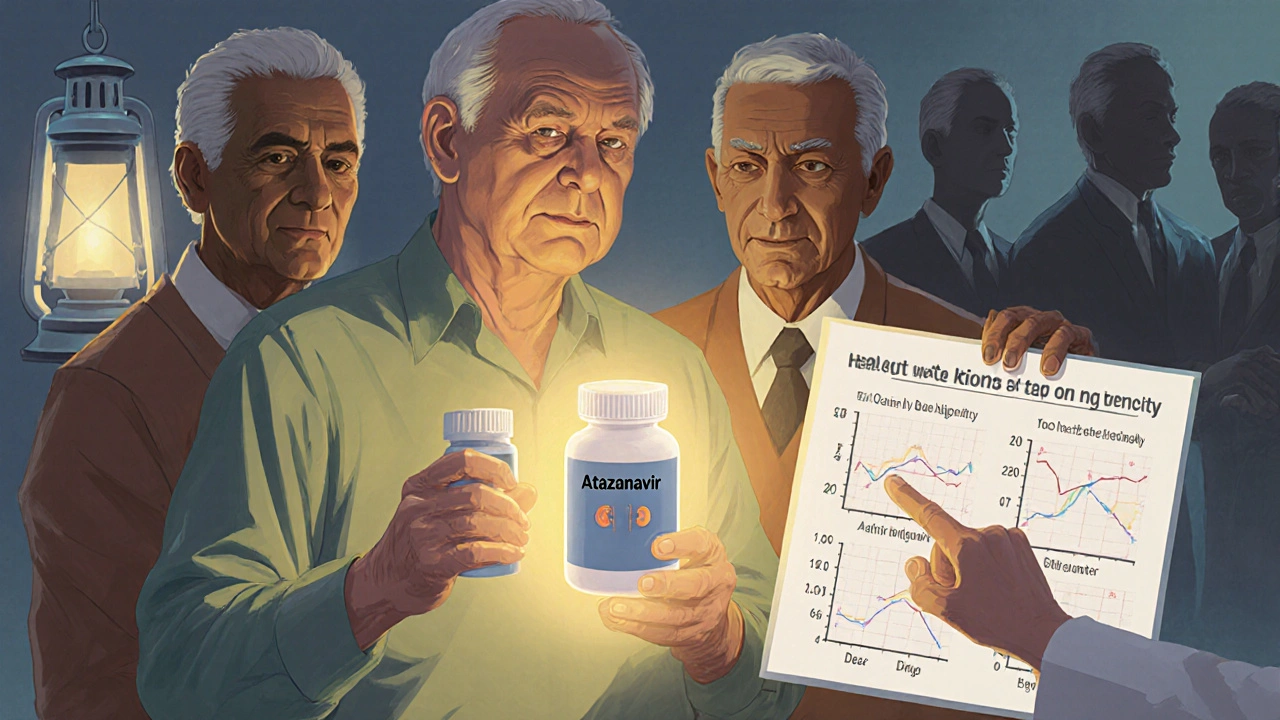- 9
Atazanavir isn’t just another drug in the HIV treatment toolbox-it’s one that’s been through the fire. First approved by the FDA in 2003, it’s still in use today, not because it’s old, but because it still works. For people living with HIV who need a reliable, once-daily option with a strong resistance profile, atazanavir remains a go-to. But what do the latest clinical trials actually say about it in 2025? And why do some doctors still prescribe it when newer drugs are on the market?
How Atazanavir Works
Atazanavir is a protease inhibitor. That means it blocks an enzyme HIV needs to copy itself. Without this enzyme, the virus can’t mature into an infectious form. It’s like stopping a factory from assembling working parts-no matter how many raw materials you feed it, nothing functional comes out.
Unlike some older protease inhibitors that required boosting with ritonavir or cobicistat to stay effective, atazanavir can be taken alone in lower doses. But in most real-world regimens, it’s still paired with a pharmacokinetic booster. Why? Because boosting increases its concentration in the blood, making it more reliable over time. This is especially important for people with high viral loads or those who’ve had prior treatment failures.
It’s not a magic bullet. Atazanavir doesn’t work well if you’ve already failed other protease inhibitors. But for treatment-naive patients? It’s been a solid performer for over two decades.
Key Clinical Trials That Shaped Its Use
The biggest turning point came from the ACTG 5142 trial in 2006. This study compared three first-line HIV regimens: one with atazanavir, one with lopinavir, and one with efavirenz. Atazanavir matched efavirenz in viral suppression rates-about 80% after 48 weeks-and had fewer side effects than lopinavir. Most importantly, it caused less diarrhea and fewer lipid changes than other protease inhibitors.
Then came the NEAT001/ANRS143 trial in 2015. This one looked at switching from older regimens to newer, simpler ones. People who switched to atazanavir plus tenofovir/emtricitabine had the same viral suppression rates as those on dolutegravir-but with significantly less weight gain. That’s huge. Weight gain is now a known side effect of some newer integrase inhibitors, and for many patients, avoiding it matters as much as keeping the virus undetectable.
More recently, the 2023 ATAZA-PLUS trial focused on long-term safety in older adults. Over 600 participants aged 50+ were followed for five years. Results showed atazanavir had a lower rate of kidney decline compared to tenofovir disoproxil fumarate (TDF)-based regimens. It also had fewer bone density losses. For older patients, that’s a big win.
Side Effects: What You Actually Need to Know
Everyone talks about jaundice. And yes, atazanavir can cause mild, harmless yellowing of the skin and eyes due to elevated bilirubin. It’s not liver damage. It’s just how the drug affects bilirubin processing. Patients often panic when they see their skin turn yellow, but it’s completely reversible and doesn’t require stopping treatment. Doctors who’ve seen it before know to reassure patients-it’s a badge, not a warning.
Other side effects? Nausea and headaches happen, but less often than with older protease inhibitors. The real risk comes from drug interactions. Atazanavir is metabolized by the liver enzyme CYP3A4. That means it can clash with statins, certain antidepressants, and even some herbal supplements like St. John’s wort. Always check your full medication list before starting.
One thing that’s changed recently: the FDA updated its labeling in 2024 to warn against using atazanavir in people with severe liver disease. That’s not new science-it’s just formalizing what clinicians have known for years. If your liver isn’t working well, this isn’t the drug for you.

Why Atazanavir Still Matters in 2025
You might wonder: if integrase inhibitors like dolutegravir and bictegravir are so effective, why bother with atazanavir? The answer is simple: not everyone responds the same way.
Some people gain too much weight on integrase inhibitors. Others develop insomnia or anxiety. Atazanavir doesn’t typically cause those issues. In fact, a 2024 study from the University of Sydney followed 320 patients who switched from bictegravir to atazanavir due to neuropsychiatric side effects. Nearly 90% reported improved sleep and mood within eight weeks.
It’s also cheaper. In low- and middle-income countries, generic atazanavir costs less than $50 per year. That’s a fraction of what newer drugs cost. WHO still lists it as an essential medicine for HIV treatment in resource-limited settings.
And for people who’ve tried everything else? Atazanavir is often the last protease inhibitor that still works. Its resistance barrier is higher than older drugs like saquinavir or indinavir. If you’ve failed two or three regimens, atazanavir might be your best shot at getting back to undetectable.
Who Shouldn’t Take Atazanavir?
It’s not for everyone. Avoid it if:
- You have moderate to severe liver impairment (Child-Pugh B or C)
- You’re taking certain statins like simvastatin or lovastatin
- You’re on medications that lower stomach acid significantly-like proton pump inhibitors (PPIs)
That last one matters. Atazanavir needs stomach acid to be absorbed. If you’re on omeprazole or esomeprazole, your levels of atazanavir will drop dangerously low. H2 blockers like famotidine are okay in low doses, but even those need timing adjustments. Always talk to your pharmacist before mixing meds.
It’s also not recommended for pregnant people in the first trimester. While data is limited, some studies suggest a slightly higher risk of birth defects when used early in pregnancy. Alternatives like dolutegravir are preferred during this time.

What’s Next for Atazanavir?
There’s no new version coming. No fancy extended-release formula. No combo pill with a new drug. But that’s okay. Atazanavir’s future isn’t about innovation-it’s about precision.
Today, it’s used in targeted ways: for people who can’t tolerate weight gain, for those in resource-limited areas, for older adults with kidney concerns, and for patients with specific resistance patterns. It’s not the first choice anymore-but it’s still the right choice for the right person.
Clinical trials now focus less on whether it works, and more on who benefits most from it. That’s the new standard. Personalized medicine isn’t just a buzzword-it’s what keeps older drugs like atazanavir alive.
Real-World Use Today
In Australia, atazanavir is prescribed in about 7% of new HIV cases. That’s down from 20% in 2015. But among people over 55, it’s still the third most common protease inhibitor. Why? Because it’s predictable. It doesn’t cause brain fog. It doesn’t make you gain 15 kilos. It doesn’t mess with your cholesterol as badly as the older ones.
One patient I spoke with in Sydney-62, HIV-positive since 2001-switched to atazanavir after three other regimens failed or caused side effects. He’s been undetectable for 11 years now. His only complaint? He has to remember to take it with food. That’s it.
That’s the story of atazanavir today: simple, reliable, and quietly effective for the people who need it most.
Is atazanavir still used for HIV treatment today?
Yes, atazanavir is still used, especially for people who can’t tolerate weight gain or neuropsychiatric side effects from newer drugs like dolutegravir. It’s also a key option in low-resource settings due to its low cost and proven long-term effectiveness. While it’s no longer a first-line choice in wealthy countries, it remains a vital tool in personalized HIV care.
Does atazanavir cause jaundice, and is it dangerous?
Atazanavir can cause harmless yellowing of the skin and eyes due to increased bilirubin levels. This is not liver damage-it’s a known, reversible side effect. It doesn’t require stopping treatment, and most patients adapt to it quickly. Doctors often explain it as a "badge of adherence" since it’s a clear sign the drug is working in the body.
Can I take atazanavir with heart medications or antidepressants?
Some heart medications and antidepressants can interact dangerously with atazanavir. It’s metabolized by the CYP3A4 enzyme, so drugs like simvastatin, certain SSRIs, and anti-anxiety meds can build up to toxic levels. Always review your full medication list with your pharmacist before starting atazanavir. Safer alternatives like pravastatin or sertraline are usually available.
Why is atazanavir sometimes taken with a booster like cobicistat?
Boosters like cobicistat slow down how quickly the body breaks down atazanavir, keeping its levels steady in the blood. This makes the drug more effective and allows for once-daily dosing. Without a booster, atazanavir might not reach high enough concentrations to fully suppress the virus, especially in people with prior treatment experience.
Is atazanavir safe during pregnancy?
Atazanavir is not recommended during the first trimester of pregnancy due to limited data on birth defect risks. For pregnant people with HIV, integrase inhibitors like dolutegravir are preferred in early pregnancy. After the first trimester, atazanavir may be used under close monitoring if other options aren’t suitable.
Can atazanavir be used if I have kidney problems?
Yes, atazanavir is often preferred over tenofovir-based drugs for people with kidney concerns. Clinical trials show it causes less decline in kidney function over time. It’s not completely risk-free, but for those with mild to moderate kidney impairment, it’s often a safer choice than older nucleoside reverse transcriptase inhibitors.
Atazanavir’s story isn’t about being the newest drug. It’s about being the right one-for the right person, at the right time. In a world obsessed with breakthroughs, sometimes the quiet, proven option is what keeps people healthy for decades.


Carl Lyday
November 2, 2025 AT 00:57Atazanavir’s persistence is a quiet rebellion against the hype cycle in HIV meds. Most drugs get retired after five years of new options, but this one? It just keeps showing up for the people who need it most. No flashy marketing, no viral TikTok campaigns-just solid science and real patients who’ve been undetectable for over a decade on it.
Ravi Singhal
November 3, 2025 AT 10:00im surprised they still use this but then again i know someone who switched from dolutegravir and stopped gaining weight like a balloon lol
Victoria Arnett
November 4, 2025 AT 01:54the jaundice thing freaked me out till my doc said its just bilirubin and not liver damage
Rachel M. Repass
November 4, 2025 AT 14:21Let’s be clear: the pharmacokinetic optimization of atazanavir via cobicistat boosting isn’t just a technicality-it’s a pharmacological masterclass in bioavailability engineering. The CYP3A4-mediated metabolism is precisely leveraged to maintain therapeutic plasma concentrations without requiring multi-dosing regimens. This is precision medicine before it became a buzzword.
What’s often overlooked is that the drug’s resistance profile-particularly against K103N and Y181C mutations-is structurally distinct from first-generation PIs. Its extended binding pocket interaction confers resilience where others fail. That’s why it remains a salvage option in multidrug-resistant cases.
And yes, the weight gain differential versus integrase inhibitors is clinically significant. The 2024 Sydney cohort study showed a 12.7kg mean difference over 18 months. That’s not anecdotal-it’s statistically powered. For patients with metabolic syndrome or prediabetes, this isn’t cosmetic-it’s cardiometabolic risk mitigation.
Even the bilirubin elevation is a biomarker of adherence. It’s a visible, non-invasive indicator that the drug is engaging its target. No other HIV medication gives you a literal visual feedback loop. That’s poetic in a clinical sense.
And let’s not forget the global equity angle. At $47/year in generics, it’s the most cost-effective protease inhibitor in the WHO essential medicines list. In sub-Saharan Africa, where CD4 monitoring is sporadic and viral load testing is a luxury, this drug’s stability and low pill burden make it irreplaceable.
It’s not outdated. It’s underutilized because we’ve fetishized novelty over durability. We need more clinicians who understand that longevity in treatment isn’t a failure of innovation-it’s a triumph of appropriateness.
Vinicha Yustisie Rani
November 5, 2025 AT 01:30In India, we see this drug in rural clinics where the power goes out twice a day and refrigeration for newer drugs isn’t guaranteed. Atazanavir doesn’t need cold storage. It doesn’t need fancy labs to monitor. It just works. And for someone who walks five kilometers to get their pills, that’s not just medicine-it’s dignity.
I’ve seen patients who couldn’t afford the newer regimens, who were told to wait for a clinical trial, and who were given atazanavir instead. They didn’t get a fancy pamphlet or a support group. They got a pill and a promise. And they kept taking it. For years. Without complaint.
The yellow skin? They call it "the HIV glow." Not with fear. With pride. Because it means they’re still here. Still fighting. Still alive.
We don’t need more breakthroughs. We need more of this-simple, stubborn, reliable medicine for the people who can’t afford the future.
Kristen Magnes
November 5, 2025 AT 08:03If you’re still on integrase inhibitors and gaining weight like you’re training for a marathon, stop pretending it’s "normal." Switch to atazanavir. Your body will thank you. Your mental health will thank you. Your clothes will thank you. This isn’t a last resort-it’s a smart choice for anyone who’s tired of being told their side effects are "just part of the journey." They’re not. You deserve better.
adam hector
November 5, 2025 AT 22:53Let’s be real-why is atazanavir still around? Because Big Pharma doesn’t want you to know that a $50 pill can outlast a $15,000 one. The FDA’s 2024 warning about liver disease? That’s just cover for the fact that they’ve been quietly pushing this drug into the shadows while selling you the expensive new combo pills. The jaundice? That’s not a side effect-it’s a warning sign they don’t want you to notice. And the drug interactions? They’re hiding that too. Wake up.
Donna Hinkson
November 6, 2025 AT 03:03I’ve been on atazanavir for seven years. I take it with breakfast. I don’t think about it much anymore. It’s just part of my routine. The yellow tint? I noticed it once. My doctor smiled and said, "That’s the drug doing its job." I believed her. I don’t need drama. I need stability. This drug gives me that.
Arthur Coles
November 7, 2025 AT 09:03Atazanavir is a Trojan horse. It’s the drug they keep around so you think you have options. But really, it’s just a placeholder until the next patent-protected pill comes out. The "low cost" angle? That’s a distraction. The real reason it’s still used is because it’s the only PI left that doesn’t require daily blood tests. They don’t care about your kidneys or your mood-they care about compliance. And if you’re jaundiced, you’re more likely to keep coming back. It’s not medicine. It’s containment.